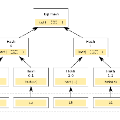Data availability (DA) attack is a well-known problem in certain blockchains where users accept an invalid block with unavailable portions. Previous works have used LDPC and 2-D Reed Solomon (2DRS) codes with Merkle trees to mitigate DA attacks. These codes perform well across various metrics such as DA detection probability and communication cost. However, these codes are difficult to apply to blockchains with large blocks due to large decoding complexity and coding fraud proof size (2D-RS codes), and intractable code guarantees for large code lengths (LDPC codes). In this paper, we focus on large block size applications and address the above challenges by proposing the novel Polar Coded Merkle Tree (PCMT): a Merkle tree encoded using the encoding graph of polar codes. We provide a specialized polar code design algorithm called Sampling Efficient Freezing and an algorithm to prune the polar encoding graph. We demonstrate that the PCMT built using the above techniques results in a better DA detection probability and communication cost compared to LDPC codes, has a lower coding fraud proof size compared to LDPC and 2D-RS codes, provides tractable code guarantees at large code lengths (similar to 2D-RS codes), and has comparable decoding complexity to 2D-RS and LDPC codes.
翻译:在某些块链中,用户接受一个没有部件的无效区块。 先前的作品使用LDPC 和 2D Reed Solomon (2DRS) 代码与Merkle 树使用LDPC 和 2D Reed Solomon (2DRS) 代码来减轻DA 袭击。 这些代码在诸如DA 检测概率和通信成本等各种指标中表现良好。 然而,由于大量解码复杂度和编码欺诈证明尺寸(2D-RS 代码),以及大代码长度(LDPC 代码)的代码保障(LDPC 代码),这些代码很难适用于大块块的区块块块。 在本文中,我们侧重于大型区块应用大型区块应用程序,并应对上述挑战,为此提出了新的极地码码码码码码码码码(PCMMT):用极码编码编码编码编码编码编码的Merkleklekle 树。 我们提供了一个专门的极地码设计算法算法算法算法,称为Smilling 节码(S-DD) 至大码的比LD-DDD码的码。




